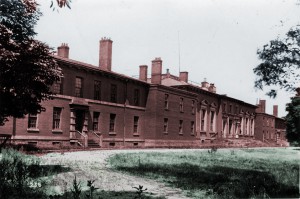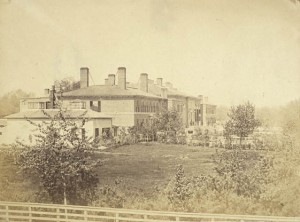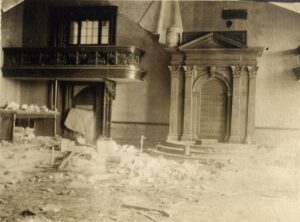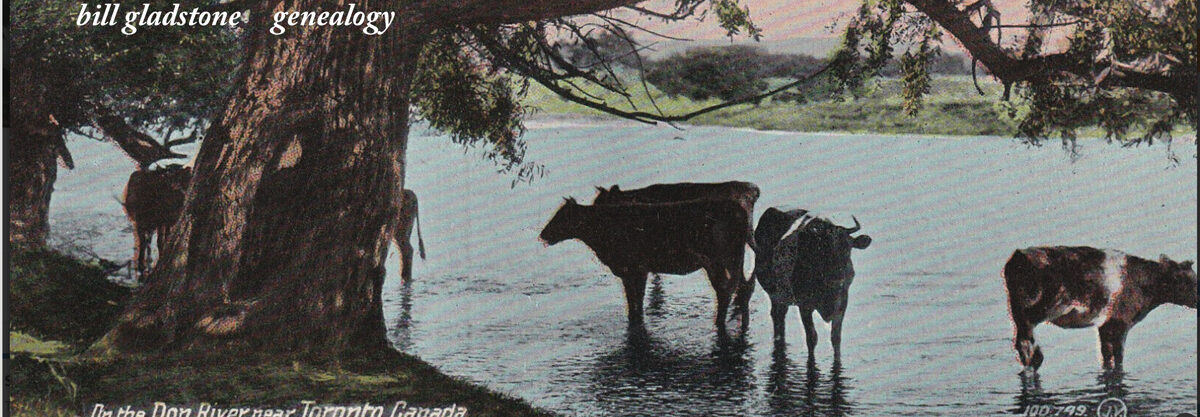From the Globe, October 27, 1902
A Centre of History: Frank Yeigh Conducts a Farewell Pilgrimage through old Parliament Buildings
 A farewell tour of inspection of the old Parliament buildings, now in process of dissolution, was paid by the Canadian Club on Saturday afternoon under the guidance of Mr. Frank Yeigh. Probably 400 persons, including many ladies, participated in the pilgrimage, which was enjoyable from every point of view, except the inconvenience which walking through the broken plaster and dismantled doors and woodwork occasioned.
A farewell tour of inspection of the old Parliament buildings, now in process of dissolution, was paid by the Canadian Club on Saturday afternoon under the guidance of Mr. Frank Yeigh. Probably 400 persons, including many ladies, participated in the pilgrimage, which was enjoyable from every point of view, except the inconvenience which walking through the broken plaster and dismantled doors and woodwork occasioned.
After the many old rooms, corridors and guard cells had been explored, the pilgrims assembled in the one-time legislative chamber, where Mr. Yeigh, in the course of a very interesting address, recapitulated briefly the history of the old buildings and narrated many of the stirring incidents which had taken place there and which were intimately connected with struggle for responsible government in this country.
He told of the first Parliament building in Toronto, a small log building erected on Berkeley street in 1796. At that time six months’ notice was required to the town to provide board and lodging for the twenty members. Another building was rendered necessary after the unfortunate visit of the American forces in 1813, when they applied the torch freely in Muddy York.
 The premises in which the visitors stood was the third Parliament house for Toronto and was first occupied in1832, being until 1841 the home of the Legislature of Upper Canada. In 1839 it was the court house, in 1846 King’s College and Medical School, from 1853 to 1855 it was Toronto University, in 1848-49 an asylum for the insance, from 1849 to 1851 the Parliament House for the Province of Canada, from 1861 to 1867 military barracks, and from 1867 to 1892 it was occupied by the Legislature of the Province of Ontario.
The premises in which the visitors stood was the third Parliament house for Toronto and was first occupied in1832, being until 1841 the home of the Legislature of Upper Canada. In 1839 it was the court house, in 1846 King’s College and Medical School, from 1853 to 1855 it was Toronto University, in 1848-49 an asylum for the insance, from 1849 to 1851 the Parliament House for the Province of Canada, from 1861 to 1867 military barracks, and from 1867 to 1892 it was occupied by the Legislature of the Province of Ontario.
Mr. Yeigh referred to the work in that chamber of such men as Wm. Lyhon Mackenzie, Alex. Mackenzie, John Macdonald, George Brown, John Sandfield Macdonald, Edward Blake, Robert Baldwin, Matthew Crooks Cameron, Oliver Mowat, Sir Allan McNab, John Beverley Robinson and many other famous Canadians. He described the riotous scenes attending the repeated appearances of Wm. Lyon Mackenzie, gave instances of the vigorous personalities which characterized the debates in the old days, and concluded by picturing the present nightly meetings of phantom parliaments, the table-rappings, the parade of the ghosts representative of the different uses to which the buildings had been put — shades which have still an existence in local tradition — to whom we would take off our hats could we realize the results of the Canadian history centred in that room.
Mr. David Creighton, who sat in the chamber as a representative for fifteen years, and Dr. George Kennedy, long intimately acquainted with the building through his connection with the Crown Lands Department, moved a vote of thanks to Mr. Yeigh, which was unanimously adopted. ♦
* * *
From the Globe, as reported in the New York Times, November 9, 1902
 TORONTO — A farewell tour of inspection of the old Parliament Buildings, now in process of demolition, was paid by the Canadian Club on Saturday afternoon under the guidance of Mr. Frank Yeigh. After the many old rooms, corridors and guard cells had been explored, the pilgrims assembled in the one-time legislative chamber, where Mr. Yeigh, in a very interesting address, recapitulated briefly the history of the old buildings and narrated many of the stirring incidents which had taken place there and which were intimately connected with the struggle for responsible government in this country.
TORONTO — A farewell tour of inspection of the old Parliament Buildings, now in process of demolition, was paid by the Canadian Club on Saturday afternoon under the guidance of Mr. Frank Yeigh. After the many old rooms, corridors and guard cells had been explored, the pilgrims assembled in the one-time legislative chamber, where Mr. Yeigh, in a very interesting address, recapitulated briefly the history of the old buildings and narrated many of the stirring incidents which had taken place there and which were intimately connected with the struggle for responsible government in this country.
He told of the first Parliament Building in Toronto, a small log building erected on Berkeley Street in 1796. At that time six months’ notice was required to the town to provide board and lodging for the twenty members. Another building was rendered necessary after the unfortunate visit of the American forces in 1813, when they applied the torch freely to Muddy York.
The premises in which the visitors stood was the third Parliament House of Toronto, and was first occupied in 1832, being until 1841 the home of the Legislature of Upper Canada. In 1839 it was the Court House, in 1846 King’s College and Medical School, in 1848-49 an asylum for the insane, from 1849 to 1851 the Parliament House for the Province of Canada, from 1853 to 1855 it was Toronto University, from 1861 to 1867 military barracks, and from 1867 to 1892 it was occupied by the Legislature of the Province of Ontario. ♦






